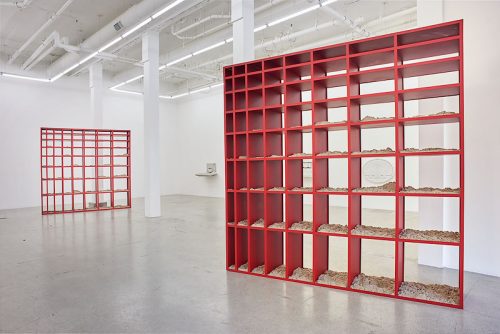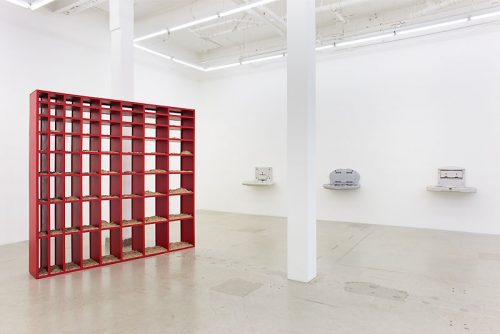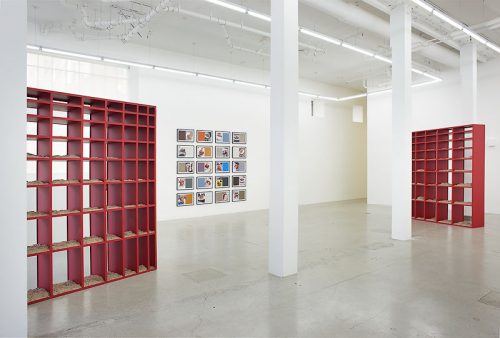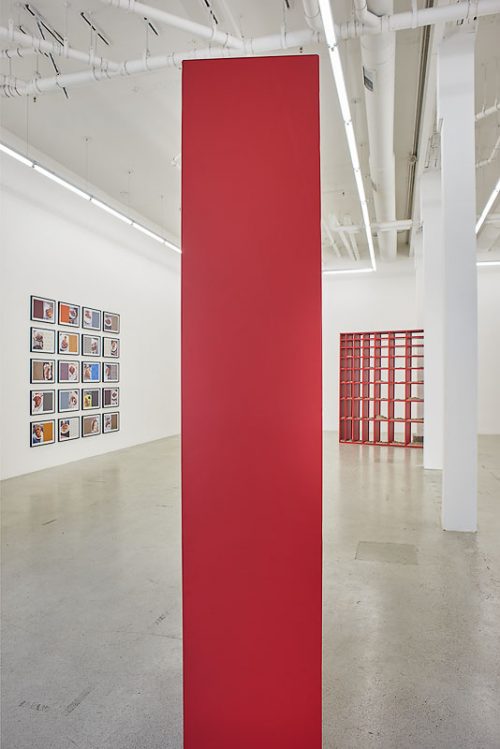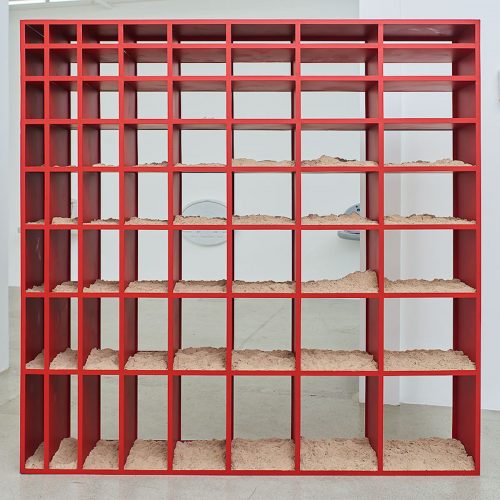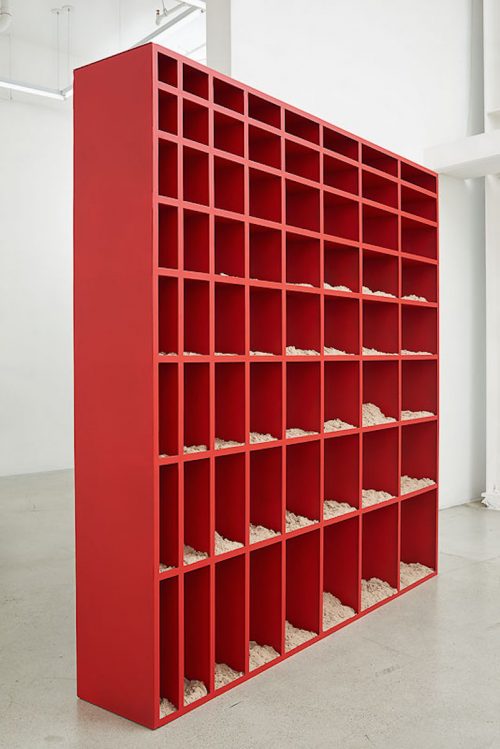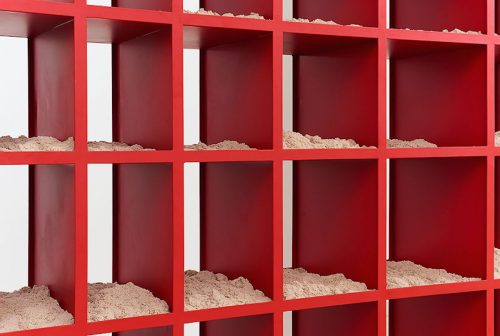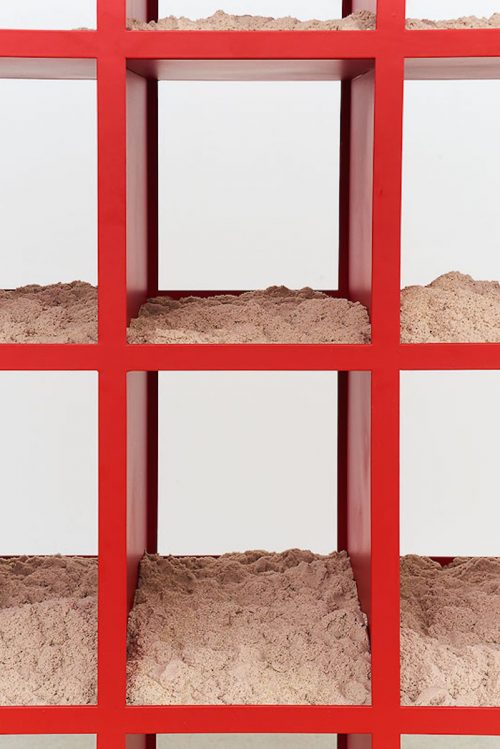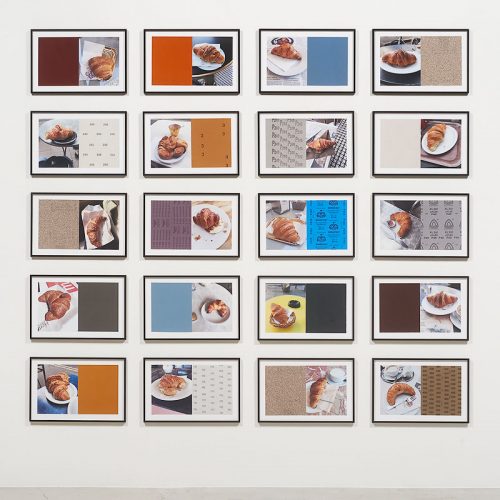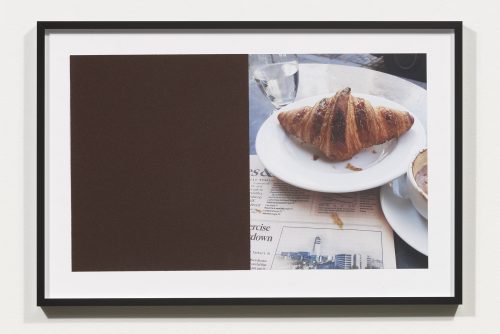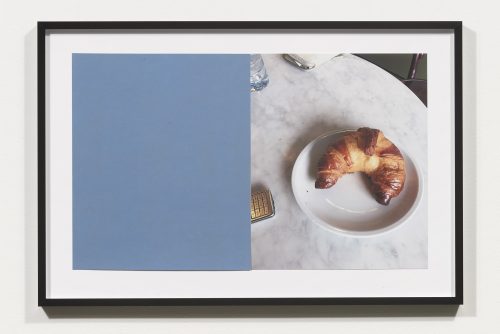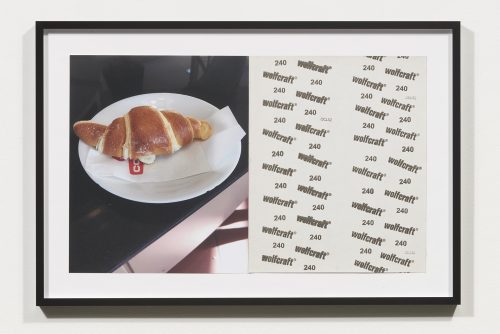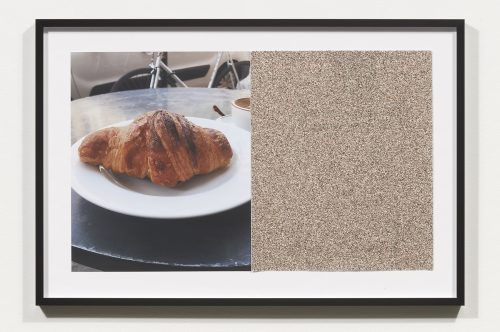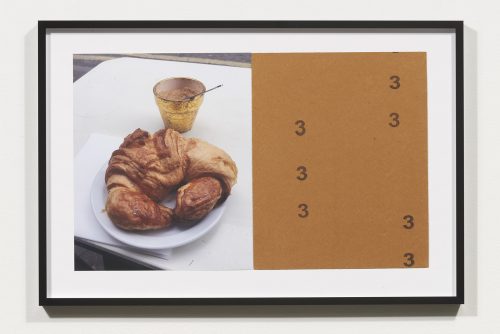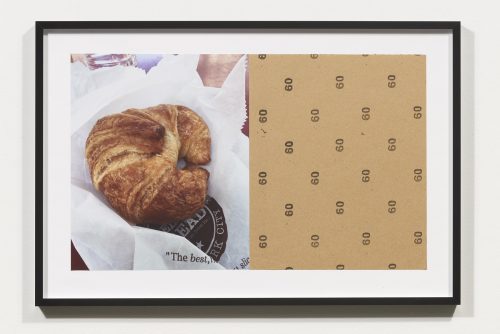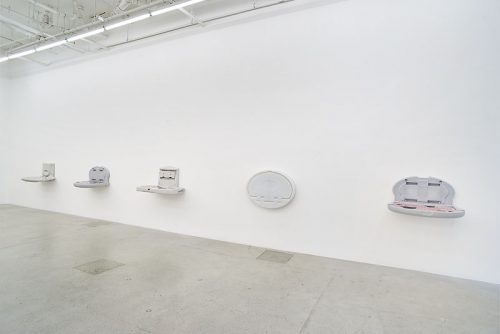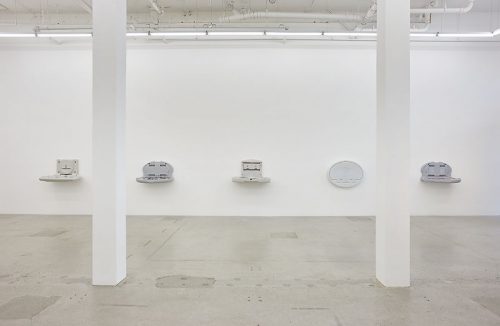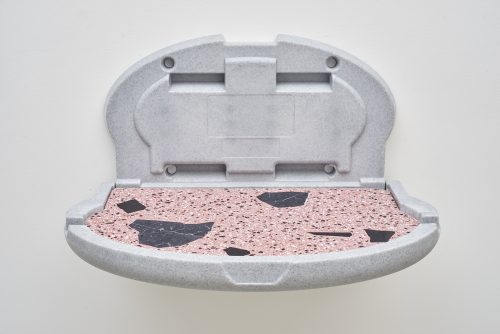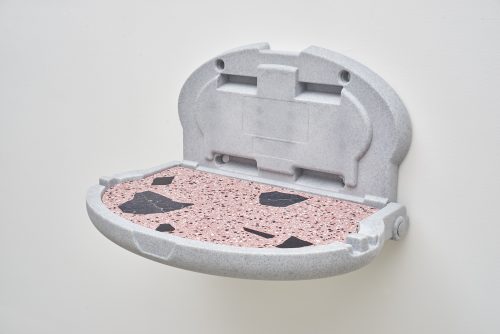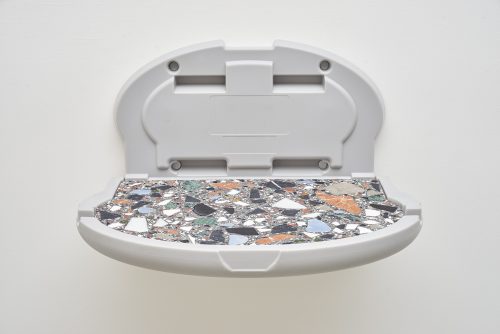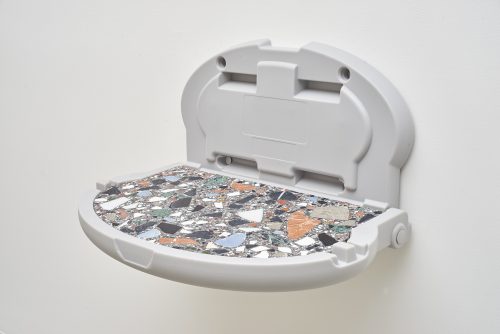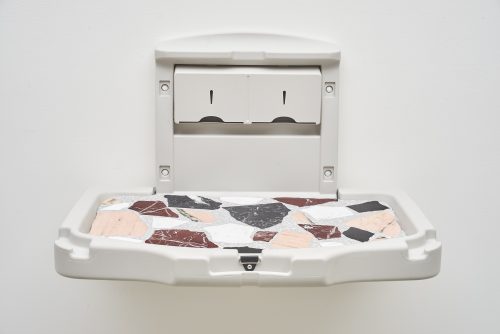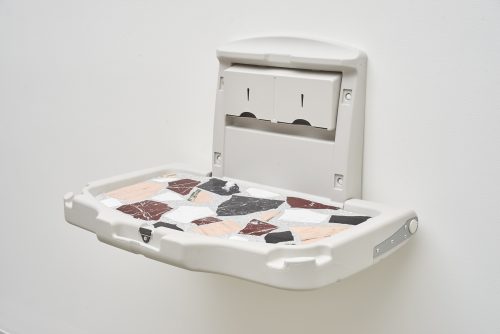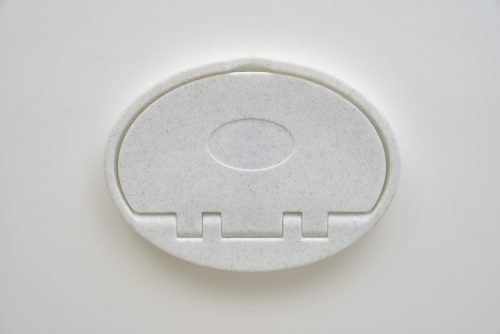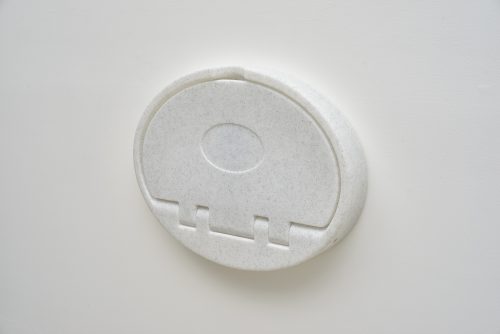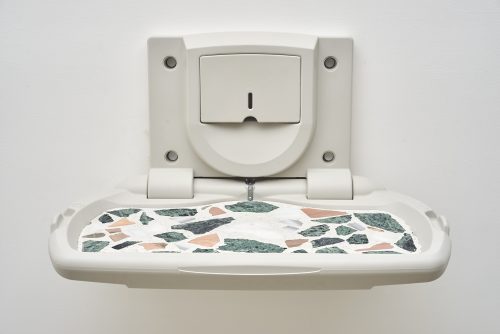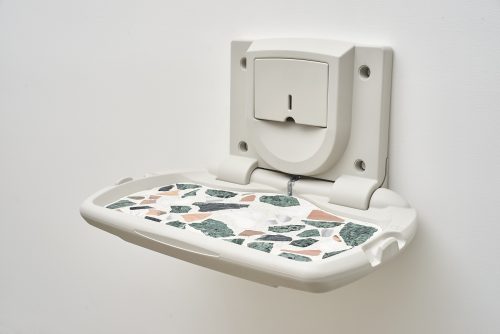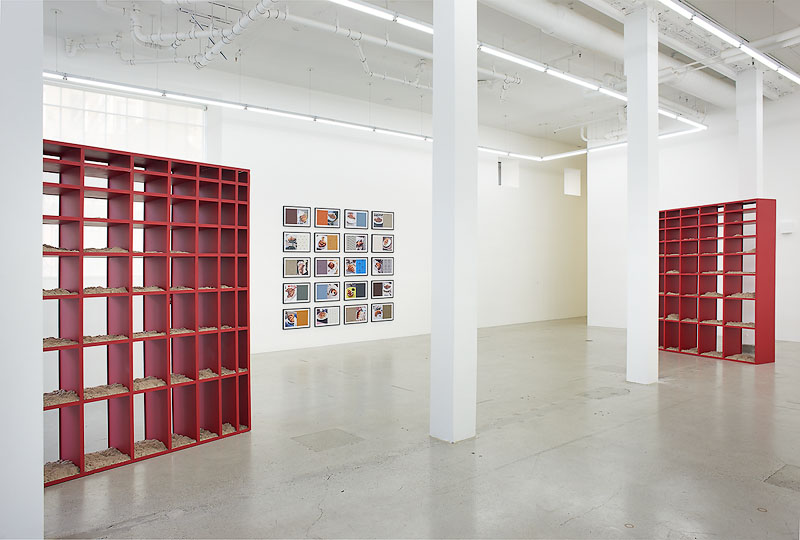
Grundstück
January 10-February 18, 2017
Opening reception: January 10, 6-8pm
Jessica Silverman Gallery is pleased to present “Grundstück,” a solo exhibition by Nicole Wermers.
Wermers creates sculptures, collages and installations, whose humor and deep psychological resonance derive from their diverse subversions. They sabotage their objects’ original function, radically rethink unusual combinations of materials, and destabilize expected spatial and social hierarchies. Wermers grew up in a small town outside Münster and, from a young age, aspired to live in a big city. Fascinated with urban environments, she developed an obsession with how they are constituted through design. “Grundstück” literally means a plot of land and connotes the process by which something flat springs into three-dimensions. The exhibition includes three recent bodies of work: “Mood Boards,” “Sand Shelves” and “Croissants & Architecture.”
Wermers’s “Mood Boards” consist of wall-hung baby-changing stations (as found in public restrooms) filled with different types of terrazzo. In the early 20th century, terrazzo was improvised by Venetian construction workers who made flooring from an aggregate of easily sourced materials including marble chips left over from upscale building jobs. In the 1980s, baby-changing stations were mass-produced to elevate babies off the floor and provide them with a platform worthy of their beloved status. With the “Mood Boards,” the foldable baby stations become frames for the display of the terrazzo, drawing attention to its hard surface and decorative beauty, as well as evoking visceral feelings about family, children, dependency, wholesomeness and impurity.
For her “Sand Shelves,” Wermers’s has appropriated an acclaimed modernist double-fronted bookcase design by Shiro Kuramata, but hollowed out the originally solid shelves. Within the resulting shallow containers, the artist has poured kinetic sand, a sculpting material and building toy, which is 98% sand and 2% silicone oil. Kinetic sand resembles brown sugar, mimics the physical properties of wet sand, and is often used for indoor play by children. It does not dry out and, although it sticks to itself, it does not cling to most other materials or surfaces. By these means, Wermers transforms a shelving unit into a landscape of vertically arranged sandboxes or “construction sites,” as she calls them. Instead of the usual reading material, the shelves now contain sand that acts like a blank page for the imagination.
A meditation on the status of works on paper and sculpture, Wermers’s “Croissants & Architecture” project juxtaposes actual sandpaper sheets with photographs of croissants shot in different European cities. Wermers collected an archive of sandpaper sheets from different decades and parts of the world, fascinated by its varied textures, monochrome colors and reverse sides, inscribed with numbers and symbols, relating to brands and degrees of roughness. By contrast, Wermers’s sees croissants as an unusual sculptural form, created by rolling and repeatedly folding paper-thin leaves of dough. Once baked, their volume is made up principally of air, so that a well-done croissant crumbles into next to nothing when subjected to pressure. Outside of France, in the 1980s, croissants became lifestyle pastries – indicators of gentrification and globalized tastes. Nowadays, croissants are passé, an outmoded form of the good life, superseded by organic superfoods and whole grain breads. By combining both the front and back of sandpaper with the images of the croissants, Wermers creates a thought-provoking tableau, which explores the changing dynamics between two- and three-dimensions, production and consumption, visceral discomfort and sensual pleasure.
Wermers’s work investigates the conceptual and formal foundations of the man-made world. It offers a unique contribution to an important strand of art history that includes artists like Isa Genzken, Robert Smithson and Pino Pascali, and designers such as Eileen Gray. Together the works in “Grundstück” offer a witty statement on the intellectual power of misuse and the jolie-laide nature of the everyday.
Nicole Wermers (b. 1971, Emsdetten, Germany) was nominated for the Turner Prize in 2015 and has exhibited widely in public institutions, including: Martin-Gropius Bau, (Berlin), Secession (Vienna), the Hayward Gallery (London), the Photographers Gallery (London), Kunsthalle Wien (Vienna), Salzburger Kunstverein (Salzburg), Museo d’Arte Contemporaneo (Rome), Kölnischer Kunstverein (Cologne), Galerie der Gegenwart/ Hamburg Kunsthalle (Hamburg), Tate Britain (London), Camden Arts Centre (London), Kunstverein für die Rheinlande und Westfalen (Düsseldorf). Wermers had a solo show at the Aspen Art Museum in 2006. She will have a solo exhibition at the Hamburg Kunstverein in early 2018 and is currently working on new public art installation, commissioned for Elevation1049 in Gstaad. Wermers is represented by Jessica Silverman Gallery, Tanya Bonakdar Gallery (New York) and Herald St (London).
- Installation view
- Installation view
- Installation view
- Installation view
-
Sand Shelf #1, 2017
Powdercoated steel, kinetic sand
91.4 x 91.4 x 16 inches / 232.2 x 232.2 x 40.6 cm
-
Sand Shelf #2, 2017
Powdercoated steel, kinetic sand
91.4 x 91.4 x 16 inches / 232.2 x 232.2 x 40.6 cm
- Installation view
- Installation view
- Installation view
-
Croissants & Architecture #28, 2016
Edition 1/2
C-print, sandpaper sheet, framed
14.4 x 21.5 inches / 36.5 x 54.6 cm
-
Croissants & Architecture #19, 2016
Edition 1/2
C-print, sandpaper sheet, framed
14.4 x 21.5 inches / 36.5 x 54.6 cm
-
Croissants & Architecture #16, 2016
Edition 1/2
C-print, sandpaper sheet, framed
14.4 x 21.5 inches / 36.5 x 54.6 cm
-
Croissants & Architecture #20, 2016
Edition 1/2
C-print, sandpaper sheet, framed
14.4 x 21.5 inches / 36.5 x 54.6 cm
-
Croissants & Architecture #12, 2016
Edition 1/2
C-print, sandpaper sheet, framed
14.4 x 21.5 inches / 36.5 x 54.6 cm
-
Croissants & Architecture #6, 2016
Edition 1/2
C-print, sandpaper sheet, framed
14.4 x 21.5 inches / 36.5 x 54.6 cm
-
Croissants & Architecture #4, 2016
Edition 1/2
C-print, sandpaper sheet, framed
14.4 x 21.5 inches / 36.5 x 54.6 cm
- Installation view
- Installation view
-
Moodboard #7, 2017
Cast terrazzo in baby changing unit
21 x 34 x 21 in / 53.3 x 86.4 x 53.3 cm
-
Moodboard #7, 2017
Cast terrazzo in baby changing unit
21 x 34 x 21 in / 53.3 x 86.4 x 53.3 cm
-
Moodboard #6, 2017
Cast terrazzo in baby changing unit
21 x 34 x 21 in / 53.3 x 86.4 x 53.3 cm
-
Moodboard #6, 2017
Cast terrazzo in baby changing unit
21 x 34 x 21 in / 53.3 x 86.4 x 53.3 cm
-
Moodboard #5, 2016
Cast terrazzo in baby changing unit
20 x 33 3/4 x 22 3/8 in. / 51 x 86 x 57 cm
-
Moodboard #5, 2016
Cast terrazzo in baby changing unit
20 x 33 3/4 x 22 3/8 in. / 51 x 86 x 57 cm
-
Dead Moodboard, 2016
Baby changing unit and fixings
25 x 34 1/16 x 3 15/16 in. / 63.5 x 86.5 x 10 cm
-
Dead Moodboard, 2016
Baby changing unit and fixings
25 x 34 1/16 x 3 15/16 in. / 63.5 x 86.5 x 10 cm
-
Moodboard #4, 2016
Cast terrazzo in baby changing unit
19 1/4 x 33 3/4 x 23 in. / 48.9 x 88.3 x 58.4 cm
-
Moodboard #4, 2016
Cast terrazzo in baby changing unit
19 1/4 x 33 3/4 x 23 in. / 48.9 x 88.3 x 58.4 cm
